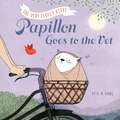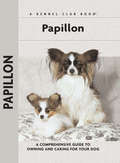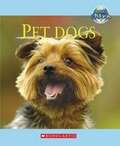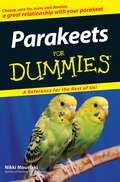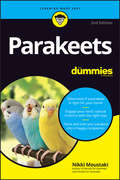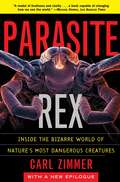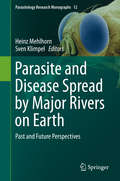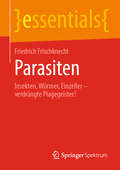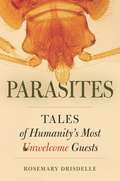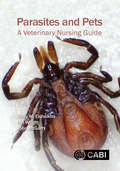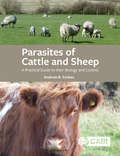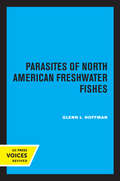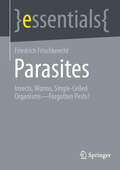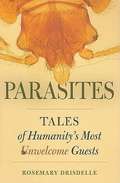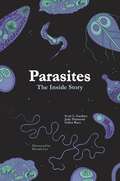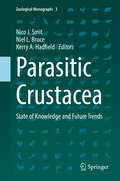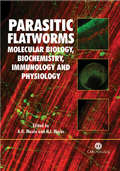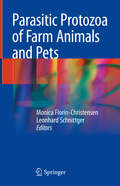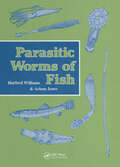- Table View
- List View
Papillon Goes to the Vet (Papillon #2)
by A. N. KangPapillon, the kitty so fluffy he floats, is back! Only this time, he's grounded. Literally. Weighed down after swallowing a toy and beset with hiccups, Papillon is miserable! Miss Tilly takes him to the vet, but will he ever float again?
Papillons (Comprehensive Owner's Guide)
by F. Michael TruexThe experts at Kennel Club Books present the world's largest series of breed-specific canine care books. Each critically acclaimed Comprehensive Owner's Guide covers everything from breed standards to behavior, from training to health and nutrition.
Papá Oso va de pesca (¡Arriba la Lectura!, Level D #64)
by Beverley Randell Isabel LowePapá Oso pesca en el río. ¿Llevará pescado para la cena? NIMAC-sourced textbook
Parade of Life: Animals
by Susan Johnson Jean Hopkins Maryanna Quon Warner Jill D. Wright Anthea Maton David La HartScience textbook for children.
Paradise House
by K. M. PeytonWhen Alice Ticino's pony bolts and crashes into a family of strangers, it changes her life. Before long, this lonely girl who has never known love has been befriended by the family and - a dream come true - is allowed to wander freely in their stables, where they train racehorses for other owners. But Alice must stay away from Snatchcorn, a beautiful stallion, so dangerous that it is soon to be put down. Alice finds that she has a special bond with Snatchcorn. Can she save his life by persuading his owner that he can be tamed?
Paradise Lane
by William TaylorWhen fifteen-year-old Rosie Perkins, an outcast at school, saves the life of a baby opossum, she finds an unlikely friend and ally in Michael Geraghty, a classmate who is her complete opposite. [From the front dust jacket flap] "No one likes Rosie Perkins. She lives in a rundown house on Old Dump Road (once called Paradise Lane), and she's too much of a loner to miss having friends. When she rescues a baby possum and lovingly takes it home, the class bullies play a loathsome trick on her: They shower her with dead possums on her way home from school. To Rosie, who only wants to be ignored, it seems like the end. Only Michael Geraghty goes back to where the boys leave Rosie. He finds her sobbing on the dusty ground, and out of remorse--a new emotion for him--he tries to apologize. But when Michael and Rosie talk, it's as if they're from different worlds, not neighboring houses: Michael's family is large and loud; Rosie's, confined and repressed. Rosie invests her possum Plum with all her love; Michael traps possums for money. But despite--or because of--their differences, they're drawn to each other. Not the tragic death of Plum, the truths Rosie uncovers about her mother, or the abuses of a possessive father can stop their feelings. A writer new to American readers brings to life two memorable characters and their extraordinary romance, which changes the life of one of them, and the thinking of both."
Parakeets (Nature's Children)
by Katie JohnDescribes the physical features, history, natural environment, care and joy of pet parakeets.
Parakeets For Dummies
by Nikki MoustakiCreate a "home tweet home" for this colorful, lively bird This plain-English guide helps readers find the right parakeet and offers expert advice on feathering his nest, from setting up the cage and selecting foods to keeping messes at bay. Readers will discover how to groom a parakeet, recognize the symptoms of illness, and keep a parakeet safe from other pets. They will also see how to teach a parakeet to talk, understand parakeet behavior, and find an avian veterinarian.
Parakeets For Dummies
by Nikki MoustakiTweet, tweet, parakeet! Your one-stop resource when you're ready to bring home a budgie There are lots of perks to owning a parakeet (also known as a budgie). This book introduces you to your beautiful budgie buddy and prepares you to give that bird a home that other avian companions will envy. Perfect for first-time bird owners and seasoned bird parents, Parakeets For Dummies offers expert advice on adopting a parakeet and introducing it to other fur or feathered babies you might have. You'll also discover the best way to groom and train your parakeet and learn how to teach it to talk. And when your feathered friend appears to be under the weather, you can turn to this book to identify the symptoms of illness and know what to look for when choosing a vet for your pet. Discover whether a parakeet is a good fit for your family, including any existing birds and other pets Construct a comfortable enclosure and prep your home so your bird can play safely Protect your parakeet from common dangers and avoidable illnesses Feed your parakeet a healthy and varied diet to ensure a long and healthy life This helpful handbook contains the latest tips and tools for parakeet care so your new family member will feel right at home right away.
Parasite Rex: Inside the Bizarre World of Nature's Most Dangerous Creatures
by Carl ZimmerCombining the literary sensibility of David Quammen with the scientific rigor of Stephen Jay Gould, Carl Zimmer reveals the power, danger, and beauty of the surprising creatures who dominate the earth: parasites.For centuries, parasites have lived in nightmares, horror stories, and the darkest shadows of science. In Parasite Rex, Carl Zimmer takes readers on a fantastic voyage into the secret universe of these extraordinary life-forms—which are not only among the most highly evolved on Earth, but make up the majority of life&’s diversity. Traveling from the steamy jungles of Costa Rica to the parasite-riddled war zone of southern Sudan, Zimmer introduces an array of amazing creatures that invade their hosts, prey on them from within, and control their behavior. He also vividly describes parasites that can change DNA, rewire the brain, make men more distrustful and women more outgoing, and turn hosts into the living dead. This comprehensive, gracefully written book brings parasites out into the open and uncovers what they can teach us all about the most fundamental survival tactics in the universe—the laws of Parasite Rex.
Parasite and Disease Spread by Major Rivers on Earth: Past and Future Perspectives (Parasitology Research Monographs #12)
by Sven Klimpel Heinz MehlhornThis book focuses on waterborne pathogens and significant diseases occurring along major rivers around the globe, including key examples like the Amazonas, Mekong River and Nile. Written by leading international experts, it offers unique insights into local riverine infection risks in times of global warming, and addressing these through advances in diagnosis, health management and the development of simple but effective control measures. It also sheds light on why former societies collapsed due to transmitted diseases during periods of climate change, droughts and floods, to help establish effective preventive measures for the future. The book appeals to a wide readership, from scientists in the field of parasitology, infectious diseases and epidemiology, to healthcare managers and general readers with an interest in pathogen spread along the largest rivers on earth. It particularly highlights past and current control mechanisms in times of global warming and assesses potential future health hazards.
Parasiten: Insekten, Würmer, Einzeller – verdrängte Plagegeister? (essentials)
by Friedrich FrischknechtFriedrich Frischknecht gibt einen interessanten Einblick in die Lebensweisen von Parasiten. Vom kleinen Erreger der Malaria zum Bandwurm, vom Durchfall zur Verhaltensänderung des Wirts stellt er die faszinierende Welt der Parasiten vor. Dabei verdeutlicht er, warum Parasitismus eine so erfolgreiche Lebensweise darstellt und wie wir es trotzdem schaffen könnten, die schlimmsten Parasiten auszurotten.Der Autor:Prof. Dr. Friedrich Frischknecht hat nach dem Studium der Biochemie an der Freien Universität Berlin am Europäischen Molekularbiologischen Laboratorium (EMBL) in Heidelberg über Pockenviren promoviert. Nach einem Forschungsaufenthalt am Institut Pasteur in Paris leitet er seit 2005 eine Forschungsgruppe am Universitätsklinikum in Heidelberg und beschäftigt sich mit den molekularen Grundlagen der Bewegung von Malariaparasiten.
Parasites
by Rosemary DrisdelleHidden away within living tissues, parasites are all around us--and inside us. Yet, despite their unsavory characteristics, as we find in this compulsively readable book, parasites have played an enormous role in civilizations through time and around the globe. Parasites: Tales of Humanity's Most Unwelcome Guests puts amoebae, roundworms, tapeworms, mites, and others at the center of the action as human cultures have evolved and declined. It shows their role in exploration, war, and even terrorist plots, often through an unpredictable ripple effect. It reveals them as invisible threats in our food, water, and luggage; as invaders that have shaped behaviors and taboos; and as unexpected partners in such venues as crime scene investigations. Parasites also describes their evolution and life histories and considers their significant benefits. Deftly blending the sociological with the scientific, this natural and social history of parasites looks closely at a fascinating, often disgusting group of organisms and discovers that they are in fact an integral thread in the web of life.
Parasites and Pets: A Veterinary Nursing Guide
by John McGarry Hany Elsheikha Dr Ian WrightThis book, primarily focussing on parasitic diseases of cats and dogs, is designed specifically for veterinary nurses and students and adopts an enquiry based approach essential for consolidating knowledge and a deep practical understanding of this important subject. The book goes beyond the conventional discourse of parasitology books, with each chapter addressing questions commonly posed by clients. It is illustrated throughout with colour figures and readers can assess their knowledge and areas for development by completing the end of chapter self-assessment questions. In this way, the veterinary nurse will be fully equipped to professionally support veterinary surgeons in achieving optimal strategies for management of parasitic diseases of companion animals. Provides a unique enquiry-based approach to assist veterinary nurses and technicians in gaining essential knowledge and practical understanding of parasites Contains self-assessment MCQ sections designed to encourage the reader to question their practice, rationales, and the evidence base of parasitology care delivery they provide to patients Focuses on the dog and cat, the most commonly seen pets
Parasites and Pets: A Veterinary Nursing Guide
by Ian Wright John McGarry Hany M. ElsheikhaThis book is designed specifically for veterinary nurses and veterinary nursing students, and adopts an inquiry-based approach to assist veterinary nurses in gaining the essential knowledge and practical understanding necessary to excel in supporting veterinary surgeons to achieve an optimal management of parasitic diseases of dogs and cats. Supported by figures and ending with learning outcomes, each chapter includes a number of questions and answers about a major group of parasites. Readers can also identify their own abilities and areas for development by completing the end-of-chapter self-assessment questions, answers to which can be found at the back of the book. The questions are designed to encourage veterinary nurses to question their practice, rationales, and the evidence base of parasitology care delivery they provide to the patients. By completing all chapters and associated exercises within this book, the readers will gain the essential parasitology knowledge and professional skills needed for parasitology practice.
Parasites of Cattle and Sheep: A Practical Guide to their Biology and Control
by Andrew B ForbesUnderstanding parasite biology and impact is essential when giving advice on parasite control in farm animals. In the first review devoted to parasites of domestic cattle and sheep alone, this book provides in-depth, focused advice which can be tailored to individual farms. It considers the impact of parasites, both as individual species and as co-infections, as well as epidemiological information, monitoring, and diagnostic procedures. Supported throughout by diagrams and photos to aid diagnosis, it also reviews the basis for control measures such as the responsible use of parasiticides, adaptive animal husbandry and other management practices. This book: Focuses on common parasites of domestic sheep and cattle; Places emphasis on understanding host responses and epidemiology so that the impact and seasonality of parasitism can be incorporated into advice and decision making; Highlights the fundamental importance of the individual farm and farmer in assessing endemic parasitism and tailoring control options accordingly; Provides a comprehensive reference listing, including important historical citations, to underpin the content. An important resource for students, veterinarians and researchers of farm animal health, this book maintains a focus on ruminant parasitology in order to deliver evidence-based advice and also context for the application of basic research.
Parasites of Marine Fish and Cephalopods: A Practical Guide
by Sven Klimpel Thomas Kuhn Julian Münster Dorian D. Dörge Regina Klapper Judith KochmannThis textbook provides a comprehensive, reliable and practical guide to the dissection and parasitological examination of marine fish and cephalopods. The first part provides a general introduction, presenting basic information on: parasitology, ecology of the marine environment, history and methods of fisheries and aquaculture, as well as the ecology of marine fish and cephalopods and the impact of parasites on hosts. In turn, the second part provides general information on the morphology and anatomy of marine fish and cephalopods using the example of abundant morphotypes (including e.g. habitus photos of the body cavity and internal organs). The third part covers the relevant parasitic groups, their ecology (e.g. lifecycles, transmission), related diseases, and detection. The fourth part, a comprehensive methods section, provides essential protocols and applications of common dissection methods (for roundfish, flatfish and cephalopods) and stomach content analyses, as well as parasite preservation, preparation and molecular identification. Basic calculations of the most common infection and ecological parameters are also introduced. The book’s fifth and final part provides information on health risks associated with fish and cephalopod consumption, as well as the prevention of human infection through the correct handling and processing of fish samples. The appendix provides e.g. blank sheets for recording fish dissections and parasitological examinations.
Parasites of North American Freshwater Fishes
by Glenn L. HoffmanThis title is part of UC Press's Voices Revived program, which commemorates University of California Press’s mission to seek out and cultivate the brightest minds and give them voice, reach, and impact. Drawing on a backlist dating to 1893, Voices Revived makes high-quality, peer-reviewed scholarship accessible once again using print-on-demand technology. This title was originally published in 1967.
Parasites: Insects, Worms, Single-Celled Organisms – Forgotten Pests? (essentials)
by Friedrich FrischknechtFriedrich Frischknecht provides an interesting insight into the lifestyles of parasites. From the tiny agent of malaria to the tapeworm, from diarrhea to changes in the host's behavior, he presents the fascinating world of parasites. In doing so, he clarifies why parasitism represents such a successful way of life and how we might still manage to eradicate the worst parasites.
Parasites: Tales of Humanity's Most Unwelcome Guests
by Rosemary DrisdellePARASITES ARE ALL AROUND US. Consider the ones that infect humans: hundreds of species live in human intestines, skin, lungs, muscle, brain, liver, blood, and everywhere else they can find a niche. Some of these parasites can live only in humans. When you realize that virtually every species of animal has a similarly large collection, and then acknowledge that plants have many as well, you begin to understand how numerous parasites really are. Even parasites have parasites.
Parasites: The Inside Story
by Judy Diamond Scott Lyell Gardner Gabor R. RáczAn exciting look at the essential roles that parasites play in Earth’s ecosystemsThis book looks at the weird and wonderful world of parasites, the most abundant form of life on Earth. Parasites come in all forms and sizes and inhabit every free-living organism. Parasitism is now, and always has been, a way to survive under changing environmental conditions. From arctic oceans to tropical forests, Scott Gardner, Judy Diamond, and Gabor Racz investigate how parasites survive and evolve, and how they influence and provide stability to ecosystems.Taking readers to the open ranges of Mongolia, the Sandhills of north-central Nebraska, the Andes of Bolivia, and more, the authors examine the impact parasites have on humans and other animals. Using examples of parasites from throughout the tree of life, the authors describe parasite-host relationships as diverse as those between trematodes and snails and tapeworms and whales. They even consider the strange effects of thorny-headed worms on their hosts. Parasites offer clues to the evolutionary history of particular regions, and they can provide insights into the history of species interactions. Through parasites, biologists can weave together a global knowledge of the past to predict the challenges that we will face in the future.Revealing that parasites are so much more than creepy-crawlies, this book gives up-to-date context for these critical members of the biological diversity of our planet.
Parasitic Crustacea: State of Knowledge and Future Trends (Zoological Monographs #3)
by Nico J. Smit Niel L. Bruce Kerry A. HadfieldThis book offers the first comprehensive review of parasitic Crustacea, which are among the most successful and diverse parasites. Starting with an introductory chapter, followed by an historic overview and topic-specific chapters, each presenting a different aspect of parasitic crustacean biology, it enables readers to gain a better understanding of how these parasites function and allows direct comparisons between the different parasitic crustacean groups. The authors also discuss, in depth, the adaptations and interactions that have made parasitic Crustacea as successful as they are today, covering topics ranging from the history of their discovery, their biodiversity, phylogeny, evolution and life strategies to their role as vectors, or hosts of other organisms, and their significance in ecological processes. Consisting of ten chapters from leading international experts in the field, this volume offers a one-stop resource for all researchers, lecturers, students and practitioners.
Parasitic Flatworms: Molecular Biology, Biochemistry, Immunology and Physiology
by Aaron G. Maule Nikki J. MarksParasitic flatworms include Cestodes (tapeworms) and trematodes (flukes, schistosomes, etc) and are the cause of a number of major diseases of medical and veterinary significance. Much recent research has focused on molecular biology and genomics. this book aims to review advances in our understanding of these and related topics such as flatworm biochemistry, immunology and physiology. Where appropriate, comparisons are made between different parasitic flatworms and between parasitic and free-living species. Contributors to the book include leading authorities from Europe, North and South America, and Australia.
Parasitic Protozoa of Farm Animals and Pets
by Monica Florin-Christensen Leonhard SchnittgerThis book provides an in-depth yet concise overview of the most common and emerging protozoa that cause diseases in both farm animals and companion animals. As outlined in the concise introduction, pathogenic protozoans represent an evolutionary highly diverse and little understood group of disease-causing microorganisms. For each of the featured parasitic unicellular eukaryotes, it discusses the morphology, lifecycle, epidemiology and host-pathogen interactions. In addition, the book highlights the latest developments in diagnostic methods, as well as prevention and treatment strategies. Thorough information on genomes and genetic manipulation strategies for some of the protozoa covered in this book is also included. Infections involving parasitic protozoa can cause productivity losses and/or reduce the quality of life of infected animals. Some infections are zoonotic, posing an on-going public health threat. In most cases, prevention and treatment are either non-existent or need considerable improvement. On the other hand, a great deal of research has recently been conducted on these organisms, yielding valuable new information on their global distribution and revealing the mechanisms of host-pathogen interactions at the molecular level – and essential insights that can be used for the development of new control tools. This book includes extensive information on both basic aspects and recent scientific discoveries on these protozoa and thus constitutes a unique resource for students, veterinarians, and researchers alike.
Parasitic Worms Of Fish
by Hartford WilliamsFish are a unique group which harbour some 30,000 species of helminths that do not occur in other vertebrates. This book deals specifically with parasitic worms of fish. It covers every aspect of their biology including identification, life-cycles, hostparasite relationships and ecology. It discusses approaches to studying parasitic worm infections, preference of species for particular host species, preference for dwelling in certain organs and tissues, biogeography, seasonality of infections and how parasites have evolved in parallel with their hosts. The book concludes with discussions of fish worms causing diseases in nature and in fish-farms.
